Entries Tagged as 'Audrey'
September 5th, 2009 · 1 Comment
A great perk about studying abroad in England is that you’re doing just that: studying. Everything we do is a learning opportunity. We constantly are taking note of the interactions between people, what groups of people are present in what area, and conversely what groups of people are absent from what areas. As much as I love this constant state of observation, I can’t help but wonder if sometimes I’m reading too much into situations. About three minutes ago when I started this blog, I planned to write on how different groups of people are treated differently throughout London. I still believe this is true. But in those three minutes, a wonderful thing happened. Space Jam came on! If you don’t remember, the movie involves Michael Jordan and Bugs Bunny saving the world from evil aliens. Talk about quality entertainment! Two children from London picked out the flick to watch before their bedtime and, being the mature people that we are, four of my fellow students and I are kindly decided to keep them company (while reciting our favorite lines right along with them). The children can’t be more than nine years old. We are all a little more than double their ages. Yet here we are all sitting around a television enjoying a Saturday night together. As this happens, I’m wondering: just how differently are separate groups of people in London? In its first couple scenes, Space Jam has told us that forced control over others is wrong, that stealing talents and goods from others is wrong, that everyone has something to learn from others, and that everyone has something to teach others- not too shabby for a movie that stars a basketball player and an animated rabbit. On our visit to a gurdwara, we were told that those who followed Sikhism believed in lifelong communal learning as well. I in no way mean to belittle Sikhism to the level of Space Jam. I do believe though that the people sitting in the lounge with me are listening to similar messages as those that are delivered in gurdwaras. With such similarities being apparent in mainstream culture and arguably a minority religious belief in London, the separation between these groups is sadly easy to recognize. This may seem paradoxical but I believe it makes sense. Clearly, the mainstream culture and minority cultures claim to believe in similar ideals: communal learning. Yet the London community is separated (making such learning difficult) based off of ethnicity, race, and class. How frustrating! I could understand if these groups’ core values or ideals were so conflicting that problems arose and, therefore, separation made a bit more sense. But that doesn’t seem to be the case. Some sort of disconnect is present. A misunderstanding between cultures? A hypocrisy in one or both? What accounts for this separation?
There doesn’t seem to be easy answer. Our class discussions have tended to point the finger at the majority culture and for the most point I’ve supported that sentiment. But I don’t know if the answer is really that simple; that is, I don’t think that the mainstream culture holds 100% of the responsibility for the separation that exists between cultures. But Space Jam reminds us that we can all get along in the end if we just communicate with one another instead of ignoring how much we have in common and highlighting our differences. That’s not to say that our differences should be completely erased. The Sikhs have a beautifully unique lifestyle that, in my opinion, shouldn’t be ‘mainstreamed’. But to have a gurdwara all the way in Southall rather than have a felt presence in London, to have Brick Lane be a predominantly Bengali community with few other places in the city where such communities exist, basically to have a separated society is, to me, exactly opposite of what all of these communities teach. Maybe Michael and Bugs need to make another movie for this lesson to be learned. I know I would gladly spend another Saturday night learning from them. But my hope is that the lesson isn’t just taught. Clearly, that is already happening. The hope is that the lesson starts being learned and applied. Maybe I’m reading too much into Space Jam’s influence on London culture. But as a student who is always observing and studying what’s going on in my surroundings, I don’t entirely think that’s the case.
Tags: Audrey
A couple weekends ago, a fellow classmate informed me that William Shakespeare is the best author of all time. Though I disagreed wholeheartedly with him, it seems that I am in the minority on this point in London. Shakespeare hasn’t been alive for many years now but (as many people have noted before me) his presence is still incredibly pervasive in English life. The revised version of the Globe Theater is filled nightly with people clamoring to get a taste of the authentic Shakespeare experience. Right across the river, the National Theater makes sure to have a Shakespeare play in its rotation regularly- something that is always well attended. After watching an entertaining but incredibly over-the-top version of Troilus and Cressida, I was prepared to write a blog about how Shakespeare in England has turned into just another tourist attraction. I paid more attention to the audience at the National Theater’s presentation of All’s Well That Ends Well though and realized that I saw more people than those who toted fanny packs around the city all day (items that I’m happy to report I have seen only a small number of). The over one thousand seats that the theater has were filled with more than a few tourists but also many who actually knew what the correct response to ‘cheers’ is (something that I’m still trying to figure out). So what? Two major theaters are showing Shakespeare plays- is that so exciting? Maybe not. But walking along the streets, you are guaranteed to see big posters advertising for Jude Law in Hamlet, Judy Dench in A Midsummer Night’s Dream, and other celebrities in lead roles in Shakespeare’s plays. Clearly, the man is still alive and well in London. Again, this might not seem that interesting considering he is known as such an infamous figure not only in the arts but in history in general. But the man has been gone for over 300 years now! Many other playwrights have produced excellent works (some that are arguably even better than anything Shakespeare has ever written) yet none of them have their shows playing in multiple theaters across the city or in annual festivals. I can’t accept that his popularity still hinges on the fact that he’s Shakespeare. Even the brightest star eventually fades away. I wonder the attraction and/or loyalty to the bard isn’t more a devotion to something else- a devotion to a desired ‘English’ identity that is found in the infamous Shakespeare. This may be a stretch but it could be an interesting point to consider.
While I was surprised to see so many London locals interested in seeing a Shakespeare play, the audience was not an incredibly diverse one at either show. The locals that were at the show were seemingly (by this untrained eye’s standards) predominantly middle-upper class, white, elderly people. There are exceptions to every rule, but this was the crowd that I most observed while there. This isn’t to say that the theaters were too pricey for the majority of Londoners. You can buy a ticket to stand in the Globe for five pounds and a ticket to sit in the National Theater for ten. While some might not have money to throw away to the theater, five pounds for entertainment is truly reasonable. Still, despite the reasonable prices, the crowd that was attracted to the show seemed to be of a certain stature. I think it’s also worth noting that neither of these shows is considered one of Shakespeare’s big hitters and yet each theater was filled as one might expect for a Hamlet or Macbeth production. Clearly it’s not the show that is so attractive but rather the playwright. And why? I would argue that Shakespeare represents an identity of old London. He represents a more homogeneous London. London today is anything but homogenous. It’s incredibly diverse and is only becoming more so with each day that passes. With the word of the trip being ‘juxtaposition’, this diversity and change is clear to even the eye of an outsider. Is holding onto Shakespeare as an image for the ‘good ol’ England a means of coping with these changes? England has had many famous icons throughout its history but few (that I’m aware of) have been so closely connected to their national pride/make-up. So while the Beatles might have brought fame to the country, Shakespeare painted a picture of what English society was like. It was a society that may have been full of class division but one that knew the Classics, was incredibly mannerly, and conversed in witty and intelligent ways. Is Shakespeare’s continued prevalence a means of keeping that identity in place? I’m not entirely certain. An argument could be made on either side. Maybe people truly never tire of his shows. I would suggest that after three hundred years, picking up some Tennessee Williams or Eugene O’Neill might be a good idea.
Tags: Audrey · Theatre
I am a law-abiding citizen. Sure, I tend to drive five miles per hour or so over the speed limit and I’ll sometimes go through a light that might be more orange than yellow but, overall, I like to think of myself as one who is in good standing with the law. Apparently, I have a lot to learn if this good relationship is going to be kept up in London. Well, my relationship with the police force here is still as strong as ever but the same cannot be said for the mall security personnel here. At the Notting Hill Carnival this weekend, Constable Bird and I chatted for a good amount of time in a very pleasant manner while waiting for the parade to start. Today at a busy Forever 21-like store, I was unable to have a similar pleasant exchange with a grumpy security man who was an active participant in the elbow throwing that was required to get through the hustle and bustle there rather than a guide in helping calm said hustle and bustle. Again, I am a law-abiding citizen. My familiarity with authority figures is pretty low. These radically different run-ins with such figures in the middle of our stay in London coincides beautifully with our reading of Caldwell’s “After Londonistan”. Well-planned, Professor Qualls. But truly, these situations and the reading together make me wonder about the law-enforcement in London. Constable Bird said something that keeps ringing in my ears: “Do people hate the police in America as much as they do here? Everyone likes to jump to conclusions about us without hearing the whole story or understanding the situation.” Well, I still might not know exactly why the security man was so angered by my misplacing a sweater on the wrong rack, but allow me to try to reason through how that situation might tie in to the relationship between civilian and authority figure that is present in London.
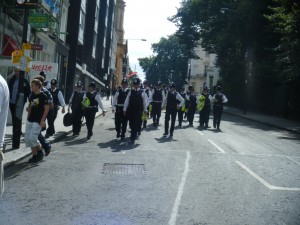
Just a part of the swarm of police coming down the hill
Notting Hill Carnival was packed. There were truly hundreds of people swarming in every direction around the community. A parade full of loud and vibrantly dressed people didn’t help in bringing any sense of order to the streets. I’ve never before witnessed such life and excitement in one area. I loved it. That vibrancy would have been tainted immensely if any unruliness (at a level above shrieking whistles being blown repeatedly for hours) broke out. To ensure this didn’t happen, the London police made sure to come down in full uniform, some on horseback. My first impression of them was one of intimidation. A mass of black and white, the police came down to the parade from on top of a hill, spread out in a way that made sure they took up the entire width of the street. Impressive and something that sent the message: don’t mess with us. After taking a few pictures, I mentally noted the message and continued to anxiously wait for the parade to begin. The police took their places as the barrier between the crowd and the parade; yes, the police were the barrier rather than a fence-like object. It was in this moment that Constable Bird and I met. We chatted about his rather snazzy uniform (the hats are particularly wonderful) and then settled on a more important matter. He complained that the police in London have a reputation of being the hot-headed, rash, and sometimes cruel enforcer figure that the press just loves to slam for any seeming mishap. This was not my experience with London’s finest at all. An officer on horseback allowed a curious and hopeful young boy to pet his horse while Constable Bird chatted about his hat, retirement preferences, and favorite spots in Notting Hill with a curious tourist. He even took a picture with us. A cruel or ticket-hungry description could not be further from the one I would give to Constable Bird and the police force that day. Intimidating, yes; unjust, no.
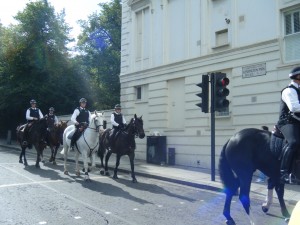
The store I visited today was packed as well. With sweaters for two pounds, it’s not a mystery why. Again, I was a bit intimidated by the security personnel there. They wore all black and were positioned at almost every clothing rack. Searching for your size while someone is scrutinizing your every move is less than calming (and size is also a very personal matter so not only are you not calm, you’re also a bit embarrassed and/or annoyed. Unfortunately, I was all three- not calm, annoyed, and trying to avoid embarrassment). I put down one of the sweaters on top of a clothing rack when I found a rain jacket I wanted to try on. I had literally just sat the sweater down when this man very harshly demanded to know if that was my item. When he found out that it was, he informed me that I was not allowed to place my item up there. Let’s set up the mental image here. I have a huge purse in between my legs, I’m wobbling as to not run into people, and I’m trying to figure out the size conversion in my head. I’m a bit of a mess. In one of my not-so-bright moments, I look around the store and ask the man where he suggests I put the item in question. He didn’t appreciate that question. Rather than answer me and try to make the situation better, he proceeded to stare me down. He just stared at me. Taking the hint, I hung the jacket back in its proper place, gathered my things, and went on my way (only after running into a person in my efforts). Yes, the situation was a tense one and I was less than polite but I don’t think my reaction deserved such a harsh reaction. While the police at the carnival actually did what they were meant to do (keep the carnival calm and running smoothly), the security man did just the opposite in scrutinizing something incredibly trivial and then refusing to offer any solution to the problem he created in the first place. What is interesting to me is the fact that of these two men, if they walked into a pub in their work attire, Londoners would probably prefer the security man’s presence over the officer’s (at least based on my understanding of the police/citizen relationship here).
Caldwell seems to make the point that London’s law-enforcement is often times rash, not well-thought out, and sometimes quite unjust. Now, Caldwell isn’t focusing on how the law treats college-aged tourists, I understand. Still, my limited exposure to the police in the area makes me believe that the law here strives towards not only fairness and equality but also ensuring the safety of the community. Balancing these is an incredibly difficult task especially in more intense situations than a street fair. But does the security man’s attitude not tell us something of the everyday person’s dealings with authority? In my totally biased opinion, it seems that those who are trying to keep the peace in London are truly trying to do just that. Still, clearly there are those who nitpick at things for reasons of lesser credibility than the greater good (I’m sorry but my sweater was truly not in anyone’s way!). I’m interested which authority figure type is more prevalent in the city: Constable Bird or angry security man. Is London a city under the protection of those who are hoping to keep the peace or under the rule enforcement of those who follow the letter of the law rather than its spirit? I’m not sure but I’m interested in figuring it out…
Tags: Audrey
August 30th, 2009 · 1 Comment
A plaque in the British Museum tells us, “Enlightened men and women believed that the key to unlocking the past and the mysteries of the universe lay in directly observing and studying the natural and the man-made world. Their passion for collecting objects, from fossils and flints to Greek cases and ancient scripts, was matched by their desire to impose order on them, to catalogue and to classify”. Let’s put on our mathematics hats on and visit the transitive property for a second. Math isn’t my strong suit but I think it works. People from the Enlightenment believed in prospering and discovering more about the world around them by collecting ideas from others. The English people have prospered and discovered more about the world around them by collecting ideas (and goods as demonstrated in the museum itself) from others. Can we not substitute the English for the people in the Enlightenment then? By my understanding of the transitive property we can. And if we do that, the British Museum puts the British people on display fantastically.
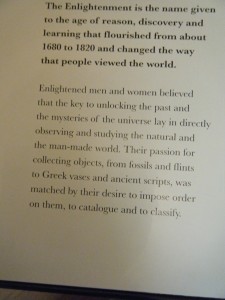
Signage in the Enlightenment room
Our class seems to be throwing around ideas about how British the British Museum really is. I’ll try to give the topic as good a go as the rest of the class has done. I think the British Museum is actually the perfect name for a museum that showcases a country that has borrowed or stolen ideas from other cultures from which they can prosper by showcasing artifacts that they have borrowed or stolen from other cultures from which they prosper. That’s an incredibly wordy way to say that the name fits because Britain itself is a lot like the exhibits the museum has: a forum of borrowed ideas and items. Not convinced? Look around at the people who are at the museum. First off, it’s incredibly crowded. Good luck getting through to see the Rosetta Stone, Cleopatra’s artifacts, the Easter Island statue, or the dancing Shiva. The crowd doesn’t simply consist of British people admiring what they have taken from other cultures. Walk through the crowd and listen to all the different languages that surround you. Chinese, Japanese, Russian, French, something that sounds like Hebrew, and, of course, English- you name it, you’ll probably hear it. Aware of this, the museum offers all of those languages on all of its important postings so that everyone who visits can navigate the museum as easily as possible (which, due to its size, isn’t very possible despite the amounts of maps available for use). As soon as you step out of the museum, you see a hot dog stand and a macadamia nut vendor and feel very much in ‘British’ London. But look around at the surrounding shops and restaurants on surrounding streets. Again, there are multiple Chinese, Thai, Indian, French, and Middle Eastern places all within walking distance (if not eyeshot) of the museum. Not only are these populations present in Britain today but they have also been influential in British history for quite some time. We’ve discussed in group discussions how today’s Britain has been shaped by the colonies it’s imperialized, by the countries it’s traded with. For years, Britain has been formed by borrowing ideas from other countries- it only makes sense that the British Museum would be composed of the work of other countries as well. In that vein, the British Museum is incredibly British in my mind.
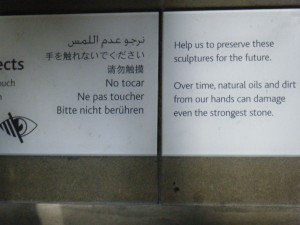
Just some of the languages listed on a sign reminding us not to touch what's on display
So if the museum is British and thus displays the British quite intensely, I’m interested in what the museum wants us to deduce from the exhibits. What does the museum think is British and how does it want to display the culture to us? Clearly, it wants visitors to see a culture that is rich in intellect, has an appreciation for the arts, and is open and proud of its diversity. I would argue that that is in line with what Britain wants to portray itself as to the world: a welcoming place in which diversity can thrive. As our last class discussion demonstrated, the success of that endeavor is debatable to say the least. But the museum at least strives to guide everyone through its walls in as equal a way as is possible by listing so many different languages on its signage. Maybe if we look hard enough, that same helping hand might be around the city as well. Maybe. Just don’t get swept away in the crowd while trying to spot such a sign.
Tags: Audrey · Museums
August 30th, 2009 · 1 Comment
I’ve noticed that my blogs tend to have an incredibly critical tone to them. As a person who usually is quite positive and tries to find the good in all situations, such a pattern is a bit upsetting or at least surprising to me. Thank goodness for the Cabinet War Rooms offering me the chance to mix up the tone a bit. What seems to be most upsetting to me about certain places I have visited while in England is if that place operates behind a façade of what it really is. St. James’ Park is beautiful and promises peaceful relaxation but is only enjoyed by a select few. Bath is beautiful because that’s what tourists want to see. The Cabinet War Rooms are a bit on the pricier side of the spectrum so admittance could be seen as selective in ways. But assuming you have the twelve pounds and some change to get in, you’re guaranteed to see and experience all that the rooms were during World War II. That sense of ‘real-ness’ is something I most appreciated about the museum. The Blitz completely changed the London atmosphere during WWII, and somehow the museum was able to capture the feelings of anxiety that one can only imagine were present in the city at that time.
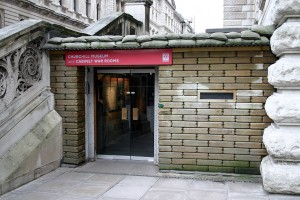
Outside view of The Cabinet War Rooms
Upon entering the museum, a feeling of eerie tension is almost inescapable. A most unpleasant guard very solemnly asked to look through my bag before I was to be admitted into the museum. I cracked an admittedly bad joke about how many maps I was carrying in it and how that might be difficult to look around in the bag. Laughter, a smile, even a twinkle of the eye was completely absent in his reaction. I recognize that he must get similar jokes all the time but his stern mood definitely set the mood for what was to come in the rest of the museum. Now, this may seem an odd experience to enter into the blog especially when I’m hoping to highlight how wonderful the museum was. Truly, I would have appreciated if he had acknowledged my attempt at being friendly but I think it’s actually good that he didn’t. The museum wasn’t a happy one. It shouldn’t have been. It was a preservation of a shelter that was put in place to ensure that communication and governance could continue in the case that an air raid might occur. As the Blitz is still a very real and felt occurrence in London’s history, the museum that seeks to capture that time should do that as fully as possible. So, having learned my lesson about keeping my jokes to myself, I proceeded through the rest of the museum. The lighting was dim, the people going through the museum quiet, the rooms closed off, and the lay out confusing. Again, this may sound like a negative review of the place but it’s exactly the opposite. More than any of the readings of personal accounts or facts about the destruction of the bombings, it was the tense atmosphere found in the museum that made the Blitz seem the most real to me. I was guided by a very thorough audio tour and yet still never knew where to go. Yes, this was frustrating but imagine how living and working in that space must have been. Churchill and his staff were living and working in that dreary underground space trying to carry on as positively and normally as possible. They were in the midst of a war with a threat of an air raid always present and surrounded by the people who are relying on them to not mess up. And if that isn’t enough pressure, they were underground- the situation could, arguably, not have been more confusing and frustrating. Those feelings are still alive in the museum. Yes, it’s a tad disconcerting to feel that strange in a museum but if you push past the feeling of ‘wow, I feel a bit uncomfortable’, you realize how fitting that feeling is for the location.
I realize that I took an odd way to describing a positive side of a museum by essentially saying “it was creepy but cool!” But that’s not so much the message. The message to me is that the museum successfully steered clear of any type of gimmicky portrayal of the war rooms and offered its visitors a chance to really sense what being in the war rooms might actually have been like. Now if only we can get rid of the cheesy gift shop and lower the price…I’ll save that for another post though.
Tags: Audrey · Museums
Let me preface all of this by saying that I am, as my fellow classmates have stated, incredibly grateful for the opportunity to see both Stonehedge and Bath– two great world heritage sites. Both trips were incredible and photograph-worthy (believe me, I took enough pictures for the entire year that day). I, however, do not share my classmates’ adoration of the city of Bath. I doubt a person exists in the world who doesn’t find the city to be one of beauty. That being said, a city built to cater to tourists is one that does not rank on my list of favorite places in the world. I recognize that I am a tourist so begrudging a city for catering to me sounds a bit odd. Truly though I would rather visit a place to appreciate what it has to offer rather than it intentionally enticing me to visit it by being built around what it thinks I might like.
At the Roman Baths themselves, I found myself most attracted to the Bill Bryson audio option on the audio tour. An author of many travel books, he was well-equipped to take me around the Roman Baths in an educational and still humorous manner. He made a comment at one of the corners that if you looked around you would see how much the site has been altered since the Romans bathed there. Following his advice, I looked around. I saw a water fountain out of which you could drink the very water that the Romans bathed in for a low, low price of fifty pence. I saw a newly remodeled bathroom that was made to look like an authentic Roman bathroom equipped with automatic sinks and hand driers. I saw outside of the baths street performers that were both incredibly talented and incredibly good at attracting large amounts of people. I then realized that I was listening to Bill Bryson. Let’s pause. Listening to him was a great way to get through the museum. But Bill Bryson? Such a recognizable name guarantees that the museum is authentic. Right? Maybe the museum was even it was being invaded by the idea of catering to the tourist while still trying to make a pound or two from the endeavor.
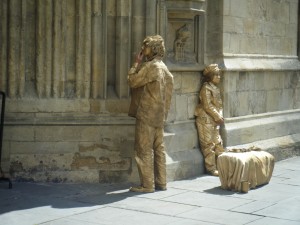
Street performers in Bath
Upon leaving the museum, a fellow student and I decided to try to capture the beauty of the city (because, truly, being built for tourists does have its perks when it comes to the overall visual beauty of the city). Deciding that the top of the hill would bring the best result for such a photo opportunity, we began our ascent. Two hours later, we realized that we were not the only one’s who thought the top of the hill was the best way to view the city. All of the residences were placed up there with beautiful views…and walls surrounding their homes to shield nosy tourists away from enjoying those views. The tourists, it seems, were to stay in the valley where they should be content to watch the street performers, shop around in cutesy boutiques, and listen to the soothing voice of Bill Bryson. I have nothing against such things! But it seems to me that if a tourist is willing to venture away from those confines and really get to know the place that is Bath, they should be able to. If a tourist wants to see and experience the landscape that the city sits upon, the true foundation of the city, they should be able to. It seems that those that profit from keeping the tourists down in the valley have other ideas. Our differences aside, the other student and I were able to get the shot (after two hours of searching). We had to climb up on a wall and duck under a few tree branches to get it, but we were successful nonetheless. When a woman who was walking her dog saw us, she rolled her eyes in a way that suggested she knew our kind all too well. “Tourists” she seemed to sigh. And as she continued to walk by, I was for once happy to have that label to hide behind as reason for my seemingly odd behavior.
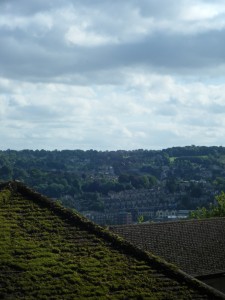
Only one of many picture taken from 'the view'
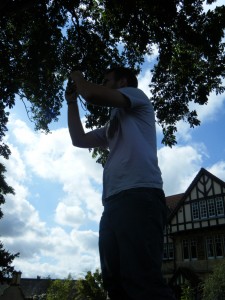
The dedication required to view Bath correctly
Just a side note: the following is a link to the criteria for a world heritage site. It’s just interesting to ponder in relation to what the city of Bath has become. List of criteria for World Heritage Sites
Tags: Audrey
St. James’ Park is incredibly beautiful. This shouldn’t come as a surprise as absolutely every park if not every tourist attraction in London could be classified in this way. Entering right across from the Cabinet Warrooms, I instantly spotted my next home. The most picturesque cottage sits on the edge of the park- one for which I instantly began planning wallpaper schemes. That’s the feeling you get at St. James’ Park though; that is, a feeling of being at home (or at least wanting it to be your home). Past the cottage, a garden of perfection leads you towards a pond that is as lovely as everything else surrounding it. Parks like these always make me grateful of those that decide to give the people of a busy city a place to go to escape the hustle, bustle, and overpriced world that engulfs them everyday to a place of peace and tranquility. Truly, St. James’ Park accomplishes that in a spot on fashion.

St. James' Park
Still, something doesn’t quite feel right in saying that all Londoners enjoy peace at St. James’ Park or in saying that the park succeeds in offering peace to everyone in the city. A quick glance around seems to show a wide range of people enjoying the tranquility. A more observant look though shows that tourists and businessmen and women are the only people in the park.

People enjoying the park
Of course this makes sense. The park is situated in between Trafalgar Square, Big Ben, Westminster Abbey, and Buckingham Palace. No tourist is able to avoid going to these locations. In a similar regard, those places are in business because businessmen and women work in them. So, when they are hoping to take a break, what better place is there than a beautiful park? But where are the parks where the people protesting for more conscientious government involvement in Iraq can rest? Where are the parks for the black man and the man from South Asia who got in a fist-fight to sit and find peace? Where are the parks for those who are fully wrapped up in the energy of the city to enjoy some respite? Yes, I walked in shoes that were too small for my feet today and certainly enjoyed a break from the fast-paced striding through the sidewalks but I recognize that my need for the park pales in comparison to the aforementioned people. It just struck me that the park which has so much beauty to offer is only enjoyed by a select few- and a select few that might not be the most ‘deserving’ or the most ‘desiring’ at that. That being said, there is no guard at the gates denying anyone entrance (at least, not that I saw). It’s just some food for thought. While I snapped picture upon picture of this pretty flower and that pretty tree, others who certainly could use some time to stop and smell the roses were probably picking up their bullhorns to ask for a government official to bring peace to the world. Hopefully if and when that happens, it can be enjoyed by all.
Tags: Audrey

The National Gallery
Laid out in an absolute beautiful mosaic, England’s National Gallery reminds its visitors in a striking fashion to show compassion to others. On the entrance landing (a spot over which all must pass and, therefore, hopefully see) the image of an angel bent down to aide a suffering woman seeks to spark in those that see it a desire or state of consciousness to remember others in need. With this image and reminder being placed before the artwork, the message of compassion is engrained in one’s mind before he or she even begins to look at the paintings he or she is there to see. How true does the message ring in us though?
Many of the paintings portray their subjects in states of need and, thus, excite a feeling of compassion for said subject in the viewer of the piece. One particular piece stood out to me. In the Degas room (room 46- the most impressive room in the gallery in my opinion), an unassuming painting of a woman hangs on the wall. The painting is relatively small and can be passed by without much notice. It displays a woman in a dull black dress facing away from the painter. She stands alone in the sparsely decorated, white room with just a table and chair (both entirely simple and plain themselves). The color of her skin is so light that she would almost blend in with the surrounding wall if it were not for her brown hair and dark dress. If you happen to see this painting in the mix of a beautiful collection of colorful Degas works, you cannot help but be transfixed by it (at least, that was the case for me). The woman appears so lonely- completely isolated in her unnoticed state. My reaction was a desire to reach out and just comfort the woman. Clearly, this cannot happen- she’s just in a painting, I realize. But the painting is a beautiful one that strikes in the viewer an overwhelming sense of compassion for the woman. Success on the National Gallery’s part? Maybe.
Maybe not though. When I was finished looking at the painting, I gathered up my things and proceeded to elbow my way through the crowd of people waiting for me to get out of their way so that they might also have a chance at viewing the painting or the one next to it. Crowds can bring out the worst in people though so let’s put that example of selfishness aside for now. Just outside of the gallery, a man stood with a sign asking us to “say no toracism”. Though he was talking with a man and thus clearly making some strides in his campaign, how many others had passed by without paying him any attention? Besides pausing to snap a photograph, I’m one of the guilty. But, sadly I would argue, I’m certainly in the majority here. Now I don’t know what the man was really hoping to get across. His sign was provocative but not informative. But if I really had learned my lesson to remember to be compassionate, to think of others, to want to help others, wouldn’t I have stopped to at least inquire what he was proposing to tackle such a feat as conquering racism? And yet I walked by. The gallery’s fault? Not at all. But I just hope that its reminder of compassion was more readily remembered by its other visitors than it was by me.

Tags: Audrey · Museums
Following another group’s visit to the Docklands, I had the advantage of advice. Based on their stories of their experiences, I knew to pay close attention to the part of the museum that focused on London’s role in the history of slave trade. The advice proved true as that was possibly the most interesting parts of the museum. Interesting only begins to describe the section, however. Nothing could have prepared me for the emotions the exhibit hit on. Opening with a list of numbers of people that were traded as commodities, the exhibit never ceased to be emotionally gripping as it portrayed the cruelty that came out of such trade. The photographs, video clips, personal accounts- everything on display made the reality of this blemish on all our histories keenly felt. The exhibit ended, for me at least, with a feeling of hope. Hope that we have learned that people are to be treated as just that- people. Hope that such mistakes will never be repeated.

Empire Windrush
Just a floor below this part of the exhibit, this hope was shaken quite a bit. Mixed in with videos of pretend interviews with the leaders of the dock strikes and boxes of exotic spices to smell, a small posting stands unassuming amongst the rest of the other relatively unimportant/of moderate importance posts. This posting mentions Windrush. As I have just visited Brixton, I knew the name to be an important one. Windrush had been a ship used just after World War II to bring Caribbean migrants over to England (advertised as “the home land” or “the Mother Country”) for the purpose of those migrants to work on the docks. To the world, this transportation of immigrants was advertised as a ‘multiculturalization’ (my word, but I think it works here) of England.

Arrivals off the Windrush
Let me start of by saying that yes, I recognize that this is in no way slavery. These immigrants were asked to come to London through job postings, they made the decision to come over, and were offered jobs, houses, and lives of their own once they arrived. But I cannot shake the feeling that there are striking parallels (or at least common threads) between these two acts. Firstly, referring to England as the Mother Country only harkens back to their days of imperialism. It would be difficult to convince me otherwise. Secondly, asking those from a country that has at any time been a colony to come to your country for the sole purpose of providing cheap labor and enticing them to come with the promise of cheap transportation seems to me like asking them to come and assume the role of someone just one step over what a slave might have been. Then to claim that this is the beginning of a multicultural society is an act that just seems ludicrous to me. Yes, these immigrants settled in community of Brixton which does bring diversity to London but to claim that this was the intent of the invitation to come to the country seems (again, this is a personal feelings) less than honorable. So while Windrush Square is in the process of being built as a community center in Brixton, I wonder if the community should feel such a strong connection to the name. Maybe using the word “should” is a bit vague. But I wonder why the name is used. Is it really honoring the community or placing a reminder of one’s place in society? Maybe I’m reading too much into things. But I’m not convinced that that’s the case. I would argue that if Brixton wanted a community center, it could be named the Brixton Community Center and no one would demand that the name have any more historical value. Again, maybe I’m wrong. I guess the hope is that I am.
Tags: Audrey · Museums

As soon as you step off the bus at Brixton, the Caribbean and African influences in the community jump out at you. Signs for jerk chicken, racks of exotic spices, fresh melons and peppers, halal butchers, and the smell of fresh fish overtake your senses. The market extends for about two to three blocks and is full of colorful clothing, food, electronics, and toiletries. It was a bit intense of an experience to see fish so fresh they might still be wriggling, chickens hanging upside down with their heads still in tact, and butchers chopping animals up in the back of a market stand. That being said, many stands boasted products that could be purchased in any local or chain vendor. When asked where the jewelry she was selling was made, a vendor replied, “The factory”. In a similar vein, a different vendor was quite angry when we took a photograph of the DVDs he was selling- proof that they weren’t necessarily the most legal of all goods? Maybe. Still, as you strolled through the market, reggae music that was from other musicians than Bob Marley met your ears to show you that the market was more than just an outdoor equivalent to any old supermarket.



The racial aspect of Brixton was quite striking. The market vendors seemed to hail mostly from Jamaica, Ghana, and Nigeria. People from many different backgrounds crowded both the main street and the market. As soon as you step off the main road, however, you find yourself in a quiet, remote residential community mostly inhabited by white people. So as you journeyed through Brixton, the community seemed quite segregated. The majority of the residential area was white while the majority of those at the market were black. The street that connected these two areas was full of people of all races but the segregation was certainly noticeable. One circumstance made this segregation quite tangible to the three us today. One white man sat in the back of a quite crowded bus next to younger black men. For reasons unbeknownst to us, the black men started yelling and cursing at the white man. When he tried to leave the men, they grabbed his paper and increased the amount of profanity they threw his way. The bus then stopped and the three of us exited quickly to the market. The incident was not violent nor was it necessarily completely race related but it seemed to be if not characteristic than at least not out of place in terms of the tensions in the area.
On the edge of the market, a small plaque sat on the wall of a building. It commemorated those who were killed in a 1999 bombing of Brixton. As we had never before known of Brixton, hearing of a bombing took us by surprise. After researching the occurrence when we got back, we were able to make more sense of it. At the edge of Electric Avenue, a nail bomb was planted by David Copeland, a member of the British neo-Nazi Socialist Movement, in the early evening of April 17th. The group is a far right anti-immigration party. When the bomb exploded, it spit out glass and nails in a 20-foot radius and injured 50 people. He was planning on attacking other cities including Brick Lane and Old Compton Street (other racially and sexually diverse communities). Police accepted his testimony that he worked alone and he was sentenced to six life sentences in prison. This bombing is not an isolated incident in Brixton’s history. It is one example of racial tension that have persisted in the area for years. During the 1980s, the tensions erupted in multiple riots. These riots were usually sparked by the community’s distrust of authority and resulted in increased community damage and heightened tensions between the police and public. This tension continues today as we witnessed in the market. A vendor poked fun at a policeman passing by asking him, “Why aren’t you smiling? You never smile! You smile when you write a ticket though.” While the policeman continued walking by unfazed, the tension between community member and authority was still evident.

As you walk away from the market up a hill, you see a construction site for a proposed community center. Windrush Station will have representations from local community groups including the Black Cultural Archives and the Brixton Society. The name “Windrush Station” comes from the British ship Empire Windrush that brought the first generation of African Caribbean settlers to Britain to Brixton. The community hopes to hold events such as Brixton Splash that celebrate community pride of Brixton. Still, the website that advertises these events has pictures of only young white people who weren’t very prominent at the market that we saw today. So, while the community center promises to increase connectivity and inclusion in Brixton, it is not without the undertones of segregation.
*sidenote* We thought there might be a connection between Eddie Grant\’s \”Electric Avenue\” and Brixton’s Electric Avenue. Comments?
Tags: Audrey · Azul · Brandon · Markets




















